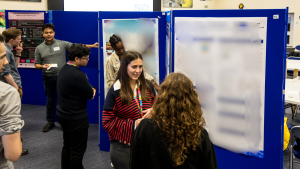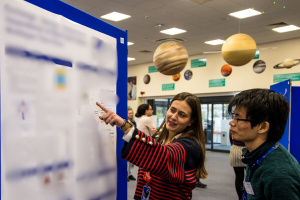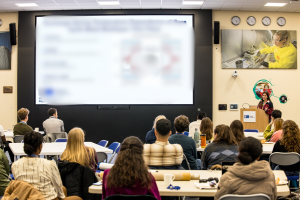
Kinga Molnar is an undergraduate student in the Department of Materials. Kinga decided to take a year away from her studies to complete a placement at ISIS Neutron and Muon Source. In this new blog post, she shares more about her experience, what she has learned and how her experience will help her in her final year of study at Imperial.
Where are you completing your placement?
I’m currently completing a student industrial placement at the ISIS Neutron and Muon Source. ISIS Neutron and Muon Source is part of the Rutherford Appleton Lab, which falls under the Science and Technology Facilities Council (STFC), and that’s part of UK Research and Innovation (UKRI). ISIS is located on the Harwell Campus, which is home to loads of other facilities and companies across a range of disciplines. At ISIS, neutrons and muons are used for all sorts of characterisation techniques: scattering, diffraction, reflectometry, so it’s a hotspot for materials science.
 How did you organise the placement?
How did you organise the placement?
I found this placement online on Gradcracker. When I first read the job description, I thought “wow, this is me!”. The job description was looking for an industrial placement student for materials characterisation, specifically in X-ray techniques, ferromagnetic resonance and magnetometry. Before applying, I made an appointment with the Careers Office at Imperial, where they helped me with my CV and Cover Letter.
I applied in the first week of October and waited for a reply. During the term, I had almost given up finding a placement opportunity, as I had received many rejections, however, on the last day of term in December, I received an interview invite for January! I was incredibly excited and very thankful to my personal tutor, Dr Sam Humphry-Baker, who guided my preparations for my interview. I recieved confirmation of my placement about a week later!
What are the aims of your project?
As an industrial placement student, my role is to continue the development of an offline ferromagnetic resonance (FMR) sample environment. This involves performing measurements on thin film permalloys in a variety of set-ups using cavity or coplanar waveguides and investigating the implications of each component on the system. Furthermore, I characterise ferromagnetic multilayer thin films containing rare-earth elements with the Superconducting Quantum Interference Device (SQUID), a bulk magnetometer. Once characterisation is finished, my job is to improve the ferromagnetic resonance set-up with the incorporation of these samples. Finally, I perform X-ray reflectometry alignment in the Rigaku Smartlab X-ray reflectometer to investigate the source of misalignment at low angles. Therefore, my day-to-day job involves sample mounting, data analysis and electrical component handling.
 What has been the highlight of your placement?
What has been the highlight of your placement?
The highlight of my placement was the Engineering Experience Programme, which is very similar to our 1st Year Design Study Coursework.
I chose to be involved in this voluntary programme, which involved a six-month-long weekly mentoring of six sixth-form students in a team of four mentors. I found it very rewarding environment since we, the four mentors, signed up for this opportunity individually, but working towards the same goal has made us excellent in teamwork.
The programme focused on helping the students to build an Early Flood Detection System. As mentors, we have grown together and were able to support the team due to our diverse experiences and disciplines of mechanical, software, materials and electronic engineering. Throughout the project we also prepared a variety of workshops from materials selection to referencing, guiding the students with writing their first ever scientific report, transferring our poster skills, demonstrating how to log their work and showing how to present in front of a facility wide audience during the celebration day in the Visitor Centre. This experience has encouraged me continue to look for opportunities to learn new skills and develop myself.
Why did you want to complete a placement with ISIS Neutron and Muon Source?
As of now, I have finished my third year studying Materials Science and Engineering (MEng), and after this placement, I will be returning to my fourth year to complete my studies. My placement at ISIS has allowed me to experience both working in both industry and academic research at the same time, and helped me to focus for my future career goals.
How does the placement relate to your degree at Imperial?
Throughout my degree, I’ve gained laboratory and teamwork experience around characterisation techniques like 3D printing, laser cutting, X-ray diffraction, electron or atomic force microscopy. This helped me to discover that I really enjoy materials characterisation and I want to learn more about materials characterisation methods involving neutrons.
As an undergraduate student, my degree is heavy in magnetism-based theory but we do not have many opportunities to perform experiments involving magnetism. Therefore, I found it a bit intimidating to start the placement on experimental ferromagnetic characterisation and be given unsupervised access to the facility! It took me a couple of months to learn how to apply the theory I’d learned to the lab, however it’s been amazing to translate my learnings from Imperial into practice.
What are you learning from the placement?
I’ve gained a lot of transferable skills, like learning how to clearly communicate ideas to my line manager and within the team, across the division and RAL. I’ve also developed the confidence to make decisions independently, how to solve problems, and know when to seek guidance.
I’ve enjoyed learning how to operate specific technical equipment like SQUID bulk magnetometer, Rigaku Smartlab X-ray reflectometer or Rohde and Schwarz VNA with their respective software. My use of Origin 2024 and LaTeX software daily will also help me with my master’s project next year.
I also had the opportunity to give talks about my project to variety of audience, for example a 15 minute long talk to our division, explaining my project and experience as a placement student. This helped me to communicate clearly, interact with professionals and be confident in answering and asking questions.
Has the placement affected your future project/career aspirations?
 My department and this degree prepared me well for this placement, thanks to the topics we have covered throughout the years. I was able to talk and interact with anyone about anything. Whether it was about biomaterials, materials for energy storage or nuclear energy, I could make a contribution to all discussions and talks and ask challenging questions to researchers. Every detail I had learned in my course, from phase diagrams to quantum mechanics, has helped me in this placement.
My department and this degree prepared me well for this placement, thanks to the topics we have covered throughout the years. I was able to talk and interact with anyone about anything. Whether it was about biomaterials, materials for energy storage or nuclear energy, I could make a contribution to all discussions and talks and ask challenging questions to researchers. Every detail I had learned in my course, from phase diagrams to quantum mechanics, has helped me in this placement.
Throughout my placement, I have also learnt how to deal with the challenge of project delays. I am still unsure about the exact career path I would like to follow, but this placement has taught me what key factors to look for when applying for a job or PhD position.
Did you learn any soft skills during the placement?
Throughout my placement, I chose to lead many tours for lead scientists to sixth-form students. I also volunteered at multiple Outreach events both on and off-site, and created four posters for a variety of conferences and events.
What is your biggest takeaway from this experience?
The biggest takeaway is that I’ve found I prefer to work in a team, as we can bring together a variety of expertise. I’ve also improved my communication skills, teamwork, flexibility, adaptability and decision making. Developing these skills has allowed me to learn how to deliver my best while being open-minded to learn from others.